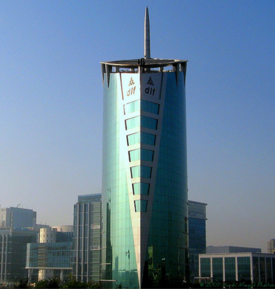Gurgaon
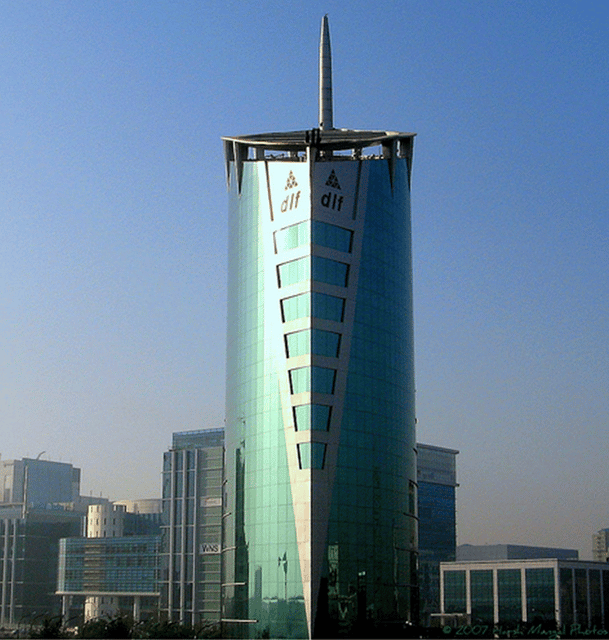
Gurgaon

Gurgaon | |
|---|---|
City | |
| Gurugram | |
from top, left to right: DLF Gateway Tower, HUDA City Centre, Gurugram city Skyline from Appu Ghar, American Institute of Indian Studies, Basai Wetland | |
| Nickname(s): Millennium city | |
| Coordinates:28°27′22″N 77°01′44″E [70] | |
| Country | |
| State | Haryana |
| District | Gurgaon district |
| Government | |
| • Body | Municipal Corporation of Gurugram |
| • Mayor | Madhu Azad |
| • MLA | Umesh Agarwal (BJP) |
| • Lok Sabha constituency | Gurgaon Lok Sabha Constituency |
| • Vidhan Sabha constituency | Gurgaon City |
| • Planning agency | Gurugram Metropolitan Development Authority |
| Area | |
| • Total | 282.7 sq mi (732 km2) |
| Elevation | 711.9 ft (217 m) |
| Population (2011)[1] | |
| • Total | 876,900 |
| • Density | 3,100/sq mi (1,200/km2) |
| Languages | |
| • Official | Hindi |
| Time zone | UTC+5:30 (IST) |
| PIN | 122xxx |
| Area code(s) | 0124 |
| Vehicle registration | HR-26 (City) HR-55 (Commercial) HR-72 (Sohna ) HR-76 Pataudi (Gurgaon) |
| Website | gurugram.gov.in [71] |
Gurgaon, officially named Gurugram, is a city located in the northern Indian state of Haryana. It is situated near the Delhi-Haryana border, about 30 kilometres (19 mi) southwest of the national capital New Delhi and 268 km (167 mi) south of Chandigarh, the state capital.[2] It is one of the major satellite cities of Delhi and is part of the National Capital Region of India.[3] As of 2011, Gurgaon had a population of 876,900.[1]
Gurgaon has become a leading financial and industrial hub with the third-highest per capita income in India.[4] The city's economic growth story started when the leading Indian automobile manufacturer Maruti Suzuki India Limited established a manufacturing plant in Gurgaon in the 1970s.[5] Today, Gurgaon has local offices for more than 250 Fortune 500 companies.[6]
Gurgaon | |
|---|---|
City | |
| Gurugram | |
from top, left to right: DLF Gateway Tower, HUDA City Centre, Gurugram city Skyline from Appu Ghar, American Institute of Indian Studies, Basai Wetland | |
| Nickname(s): Millennium city | |
| Coordinates:28°27′22″N 77°01′44″E [70] | |
| Country | |
| State | Haryana |
| District | Gurgaon district |
| Government | |
| • Body | Municipal Corporation of Gurugram |
| • Mayor | Madhu Azad |
| • MLA | Umesh Agarwal (BJP) |
| • Lok Sabha constituency | Gurgaon Lok Sabha Constituency |
| • Vidhan Sabha constituency | Gurgaon City |
| • Planning agency | Gurugram Metropolitan Development Authority |
| Area | |
| • Total | 282.7 sq mi (732 km2) |
| Elevation | 711.9 ft (217 m) |
| Population (2011)[1] | |
| • Total | 876,900 |
| • Density | 3,100/sq mi (1,200/km2) |
| Languages | |
| • Official | Hindi |
| Time zone | UTC+5:30 (IST) |
| PIN | 122xxx |
| Area code(s) | 0124 |
| Vehicle registration | HR-26 (City) HR-55 (Commercial) HR-72 (Sohna ) HR-76 Pataudi (Gurgaon) |
| Website | gurugram.gov.in [71] |
History
The region of Gurgaon originally fell under the Kuru Kingdom.[9] The earliest people to inhabit the city were Hindus of the Ahir clan during the vedic era.[10] Yadu tribes were a part of this clan and today their descendants commonly hold the last name Yadav. In the Mahabharata, Gurgaon is described as the village of Guru Dronacharya, the guru of the Kauravas and Pandavas.[11] In late 4th century BCE, the city was absorbed by the Maurya Empire as part of Chandragupta Maurya's earliest expansions of his kingdom.[12]
During mughal and initially during the British colonial era, Gurguram was just a small village in Jharsa paragana of Delhi subah. Report of a Tour in Eastern Rajputana in 1882-83 (Published in 1885) by Alexander Cunningham, the then Director-General of Archaeological Survey of India, he mentions a stone pillar at Gurugaon of a local feudal lord "Durgga Naga" with a 3-line inscription "Samvat 729 or 928, Vaisakh badi 4, Durgga Naga lokatari bhuta" dating back to 672 AD or 871 AD. Jharsa paragana passed to Begum Samru in 1776-77 and came under direct British rule in 1836 after her death when her territory was taken over by the British who established a civil lines at Jharsa and a cavalry cantonment at nearby Hiyadatpur. A 1882 land revenue settlement report records that the idol of Sitla Mata was brought to Gurugram 400 years earlier (15th century). Begum Samru claimed the offering to Sitla Mata temple during the Chaitra month and the revenue from the offerings given to the deity for rest of the month was distributed among the prominent Jat zamindars of the area.[15] In 1818, Bharawas district was disbanded and Gurugram was made a new district. In 1821, the Bharaswas cantonment was also moved to Hidayatpur in Gurugram.[16] "Aliwardi mosque" in Gurugram, "Badshahpur baoli" (1905).[17][18] and "Bhondsi" (16th to 17th century) were built during mughal and British era.[19] The "Church of the Epiphany" and "Kaman Serai" (Corrupted form of the "Command Serai" or Officer's Mess") was built by the Britishers in 1925 inside the civil lines.[19]
On 12 April 2016, Chief Minister of Haryana Manohar Lal Khattar announced a proposal to officially rename the city Gurugram (Sanskrit: गुरुग्राम, lit. village of the Guru), subject to the approval of the Haryana cabinet and the Union Government. He argued that the new name would help to preserve the "rich heritage" of the city by emphasising its history and mythological association with Dronacharya.[20][21][22] On 27 September 2016, he officially announced that the Union Government had approved the name change, and thus the city and district would henceforth be known as Gurugram,[23] though the old name "Gurgaon" still lingers in the colloquial usage.[24]
Geography
Gurgaon is located in Gurgaon district in the Indian state of Haryana and is situated in the southeastern part of the state, and northern part of the country. The city is located on the border with Delhi with New Delhi to its northeast. The city has a total area of 738.8 square kilometres (285.3 sq mi)[25]
Topography
The average land elevation is 217 metres (712 ft) above sea level.[26]
Ecology
Gurugram lies on the Sahibi River, a tributary of Yamuna which originates from the Aravalli range in Rajasthan and flows through west and South Haryana into Delhi where it is also known as the Najafgarh drain. The paleochannel and the current course of the Sahibi river have series of biodiversity hotspots and Important Bird Area (IBA) wetlands and forests within Gurugam, including the Outfall Drain Number 6 (canalised portion in Haryana of Sahibi river), Outfall Drain Number 8 (canalised portion in Haryana of Dohan river which is a tributary of Sahibi river), Sarbashirpur wetland, Sultanpur National Park, Basai wetland, Najafgarh lake and Najafgarh drain bird sanctuary, Ghata lake, Badshahpur lake, Khandsa lake and The Lost lake of Gurugram.[27] Other IBA wetlands along the Saibi river, outside Gurugram district, are the Masani barrage wetland, Matanhail forest, Chhuchhakwas-Godhari, Khaparwas Wildlife Sanctuary, Bhindawas Wildlife Sanctuary, etc. All of these are home to endangered and migratory birds. Most of these largely remain unprotected. These are under extreme threat mainly from the colonisers and builders.
Mangar Bani, a sacred grove and forest with wetlands between Gurugram and Faridabad, is one of the last surviving natural forest in NCR is protected by Gurjars of nearby area.[28] continguous to Mangar bani are Gwal Pahari and Bandhwari forested area. All of these lie on the Southern Delhi Ridge of Aravalli range.
Climate
Under the Köppen climate classification, Gurgaon experiences a monsoon-influenced Composite climate .[29] The city experiences four distinct seasons - spring (February - March), summer (April - August), fall/autumn (September - October) and winter (November - January), along with the monsoon season setting in towards the latter half of the summer. Summers, from early April to mid-October, are typically hot and humid, with an average daily June high temperature of 40 °C (104 °F). The season experiences heat indices easily breaking 43 °C (109 °F). Winters are cold and foggy with few sunny days, and with a December daytime average of 3 °C (37 °F). The Western Disturbance brings some rain in winters that further adds to the chill. Spring and autumn are mild and pleasant seasons with low humidity. The monsoon season usually starts in the first week of July and continues till August. Thunderstorms are not uncommon during the Monsoon. The average annual rainfall is approximately 714 millimetres (28.1 in).[29]
| Climate data for Gurgaon | |||||||||||||
|---|---|---|---|---|---|---|---|---|---|---|---|---|---|
| Month | Jan | Feb | Mar | Apr | May | Jun | Jul | Aug | Sep | Oct | Nov | Dec | Year |
| Average high °C (°F) | 21.1 (70.0) | 24.2 (75.6) | 30.0 (86.0) | 36.2 (97.2) | 39.6 (103.3) | 39.3 (102.7) | 35.1 (95.2) | 33.3 (91.9) | 33.9 (93.0) | 32.9 (91.2) | 28.3 (82.9) | 23.0 (73.4) | 31.4 (88.5) |
| Average low °C (°F) | 7.3 (45.1) | 10.1 (50.2) | 15.4 (59.7) | 21.5 (70.7) | 25.9 (78.6) | 28.3 (82.9) | 26.6 (79.9) | 25.9 (78.6) | 24.4 (75.9) | 19.5 (67.1) | 12.8 (55.0) | 8.2 (46.8) | 18.8 (65.8) |
| Average rainfall mm (inches) | 20.3 (0.80) | 15.0 (0.59) | 15.8 (0.62) | 6.7 (0.26) | 17.5 (0.69) | 54.9 (2.16) | 231.5 (9.11) | 258.7 (10.19) | 127.8 (5.03) | 36.3 (1.43) | 5.0 (0.20) | 7.8 (0.31) | 797.3 (31.39) |
| Average rainy days | 1.7 | 1.3 | 1.2 | 0.9 | 1.4 | 3.6 | 10.0 | 11.3 | 5.4 | 1.6 | 0.1 | 0.6 | 39.1 |
| Mean monthly sunshine hours | 213.9 | 217.5 | 238.7 | 261.0 | 263.5 | 198.0 | 167.4 | 176.7 | 219.0 | 269.7 | 246.0 | 217.0 | 2,688.4 |
Demographics
The Gurgaon municipal corporation area has an estimated population of 876,900, according to the 2011 Census of India.
Religion
Hinduism is the most popular religion in Gurgaon, followed by Islam, and Sikhism. There are small amounts of Christian, and Buddhist followers. Gurgaon has adherents of Hinduism, Sikhism, Islam, Buddhism, Jainism, Christianity and the Bahá'í, amongst others. There are several places of worship for major religions, including mandirs, gurdwaras, mosques and churches.
Sheetla Mata Mandir is a temple dedicated to the wife of Guru Dronacharya.[30] The temple hosts fairs and people come to seek blessings of Sheetla Mata. Sai Ka Aangan temple is dedicated to Shri Shirdi Sai Baba run by Sai Prakash Spiritual and Charitable Trust. The temple is Spread over an area of 4000 square yards and is located in Sushant Lok 1 area of the city.
Cityscape
Architecture

Cyber Green Building
Gurgaon has architecturally noteworthy buildings in a wide range of styles and from distinct time periods. Gurgaon skyline with its many skyscrapers is nationally recognised, and the city has been home to several tall buildings with modern planning. Gurgaon has an estimated 1,100 residential high-rises.[32] The average cost of a 93-square-metre (1,000 sq ft) two-bedroom apartment at a decent condominium in Gurgaon is at least $160,130 (₹10,000,000).
Neighbourhoods
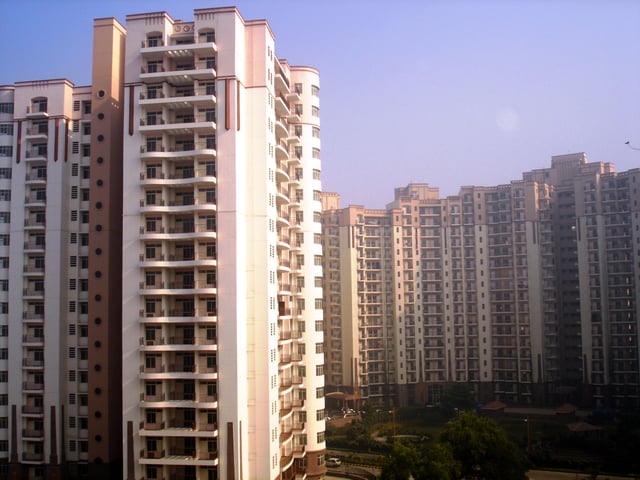
Essel Towers, Gurgaon
Gurgaon is divided into 36 wards, with each ward further divided into blocks. The housing type in the city consists largely of attached housing, though a large number of attached multi-dwelling units, including apartments, condominiums and high rise residential towers are getting popular.
Parks
Gurgaon has a complex park system, with various lands operated by the Gurugram Metropolitan Development Authority. The key parks are Leisure Valley Park in Sector 29, which is over 15 hectares (36 acres); Tau Devi Lal Biodiversity Botanical Garden in Sector 52; Netaji Subhash Chandra Bose Park in Sector 14, popularly known as HUDA Garden; Tau Devi Lal park in Sector 23; and Aravali Biodiversity Park on MG Road. Most of the parks in Gurgaon are small and ill-maintained. There are local parks in almost all sectors in Old Gurgaon.[33]
Culture
Entertainment and performing arts
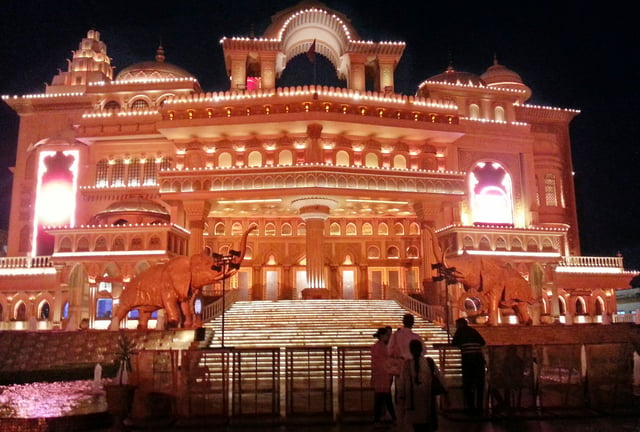
Kingdom of Dreams
Notable performing art venues in the city include Epicentre in Sector 44 and Nautanki Mehal at the Kingdom of Dreams near IFFCO Chowk. Bollywood actor Rajkummar Rao was born in Gurgaon .
Languages and dialect
The main language spoken in Gurgaon is Hindi, though a segment of the population understands and speaks English. The dialect used in Hindi is similar to that of Delhi, and is considered neutral, though the regional influences from the states of Haryana, Uttar Pradesh and Punjab adds an accent to the language. English is spoken with an Indian accent, with a primarily North Indian influence. Since Gurgaon has a large number of international call centres, the employees are usually given formal training in neutral pronunciation in order to be understandable to native English speakers. Haryanvi and Punjabi are other popular languages spoken in the city. The other regional languages include Mewati and Haryanvi.Other language is Ahirwati, it is an Indo-Aryan language, classified as a Rajasthani language, and is spoken in the Mahendragarh, Rewari and Gurgaon districts of Haryana.[34][35]
Religion
Sheetla Mata Mandir is a temple dedicated to the wife of Guru Dronacharya.[36] The temple hosts fairs and people come to seek blessings of Sheetla Mata. Sai Ka Aangan temple is dedicated to Shri Shirdi Sai Baba run by Sai Prakash Spiritual and Charitable Trust. The temple is Spread over an area of 4000 square yards and is located in Sushant Lok 1 area of the city.
Sports
The city has two major sports stadiums: Tau Devi Lal Stadium in Sector 38, which has facilities for cricket, football, basketball and athletics as well as a sports hostel, and Nehru Stadium which is designed for football and athletics. Amity United FC is a tenant of Tau Devi Lal Stadium. Gurgaon district has nine golf courses, and is described as the "heart of India's golfing country".[37] Joginder Rao, a domestic cricket player was from Gurgaon.
Economy

A commercial area in the DLF Cyber City.
Gurgaon has the third-highest per-capita income in India,[4][38] and is the site of Indian offices for half of Fortune 500 companies. The city also benefits from its close proximity to Delhi. Maruti Suzuki Private Limited was the first company that set up a manufacturing unit in the city in 1970s making cars.[5] Eventually, DLF Limited, a real estate company acquired vast stretches of land in the city. The first major American brand to set up a unit in Gurgaon was General Electric in 1997. GE's setup in Gurgaon prompted other companies, both international as well as domestic, to follow suit[39] providing outsourcing solutions in software, IT, service and sales through delivery facilities and call centres. However, due to the lack of proper public transport and the inability of most of the employees to afford a personal vehicle, most of the call centres provide pooled-in cars to and from their offices.[39] Apart from Business process outsourcing and IT sectors, the city is home to several other companies that specialise in domain expertise. Siemens Industry Software, in Gurgaon Business Park, made a portfolio of design software that was used by NASA to digitally design, simulate and assemble the vehicle before any physical prototypes were built.[39] Various international companies, including Coca-Cola, Pepsi, BMW, Agilent Technologies, Hyundai have chosen Gurgaon to be their Indian corporate headquarters.[39] All the major companies in the city depend on their own backup, given the fact that Gurgaon does not have reliable power and water supply, public transport and utilities. Retail is an important industry in Gurgaon, with the presence of 26 shopping malls.[40]
All Nippon Airways, a Japanese airline, maintains its Delhi sales office in the Time Tower in Gurgaon .[41]
Law and government
Gurgaon is governed by the Municipal Corporation of Gurugram which follows a Mayor-Council system.[42] In 2017, (Gurugram Metropolitan Development Authority) was formed. GMDA looks after the Infrastructure and also has improved a lot of city's infrastructure.
Crime
The city reported 89 homicides in 2012. The total vehicle thefts registered by the police in Gurgaon in 2014 was 3,638.[43]
The police department in Gurgaon is headed by the Commissioner of Police - Gurugram Police, which forms a part of the Haryana Police.[44] and reports to the Haryana state government. In 2018 KK Rao (IPS) was appointed Commissioner of Police in Gurgaon.[45] Gurugram Police has a separate traffic police department headquartered in sector 51.[46] Fire protection within the city limits is provided by Municipal Corporation of Gurugram through four fire stations, located in sector 29, sector 37, Udyog Vihar and Bhim Nagar.[47]
Education
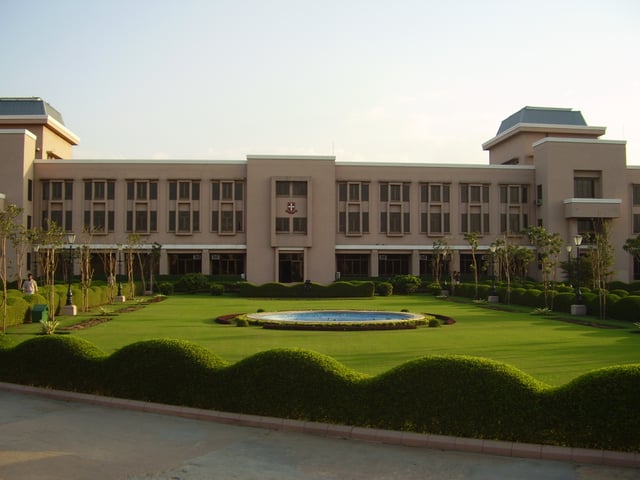
ITM Campus (now The Northcap university) in Gurgaon
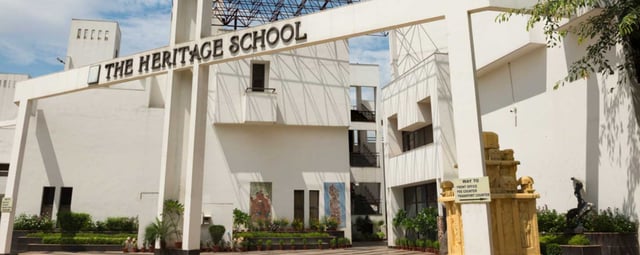
Heritage Xperiential Learning School
The city's public school system is managed by the government of Haryana, and administered by Haryana Board of School Education.
There are several universities and institutes located in Gurgaon and the surrounding area, including newly established Gurugram University, Sushant School of Art and Architecture & Ansal University, Sector 55; ITM University, Sector 23A; GD Goenka University, Sohna Road; KR Mangalam University, Sohna Road; Amity University, Gurgaon, Manesar; Apeejay Stya University, Sohna; BML Munjal University, NH8; Shree Guru Gobind Singh Tricentenary University, Budhera;[48] and National Brain Research Centre, Manesar.
Transport
Roadways
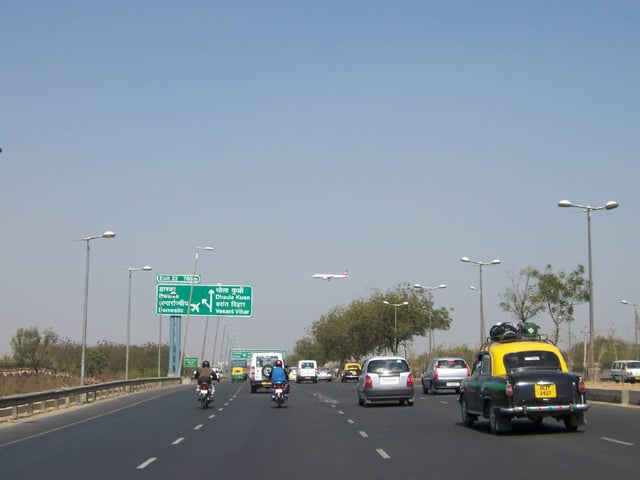
Delhi Gurgaon Expressway
The major highway that links Gurgaon is National Highway 48, the road that runs from Delhi to Mumbai. While the 27.7-kilometre (17.2 mi) Delhi-Gurgaon border-Kherki Dhaula stretch has been developed as an expressway, the rest is expanded to six lanes.[49]
Railways
Intercity rail
Gurgaon railway station is operated by Northern Railway of Indian Railways. The rail station forms a part of the larger Indian Railways network. Along with that, Gurgaon has Tajnagar railway station, Dhankot railway station, Ghari Harsaru Railway Junction and Farrukhnagar Railway Station, Patli Railway Station. Under Modernisation of Railway Station, Indian Railway is modernising four railway stations in Gurgaon. Gurgaon railway station, Ghari Harsaru Railway Junction and Farrukhnagar Railway Station will be developed and modernised with modern amenities and international facilities.
Delhi Metro

HUDA City Centre metro station on the Yellow Line of Delhi Metro
There are five stations served by Delhi Metro Rail Corporation Ltd. located on the Yellow Line, which are HUDA City Centre, IFFCO Chowk, MG Road, Sikanderpur and Guru Droncharya. Extension of Delhi Metro Yellow line is approved by Haryana Government, in which the line started from HUDA City Centre go through Subhash chowk up to Gurgaon railway station via Hero Honda chowk and Sector 9 and Sector 5 road, from Gurgaon railway station it goes to Old Delhi road Sector 23 near Palam Vihar chowk at Columbia Asia Hospital via Sheetla Mata road and Old Delhi–Gurgaon road. This Yellow line extension having a interchange with Delhi-Gurgaon-Rewari-Alwar RRTS corridor and Extension of DLF Gurgaon rapid metro at Old Delhi road. The total length of this line up to Sector 23 as of now is around 20-22 km. In near future it will extended from sector 23 to Dwarka expressway interchange with another metro line going toward Dwarka.
Rapid Metro

Rapid Metro station near Phase 2.
Rapid Metro has eleven stations in Gurgaon, with an interchange with Yellow Line of Delhi Metro at Sikandarpur metro station. The Rapid Metro became operational in November 2013 and currently covers a distance of 11.7 kilometres (7.3 mi).[50] One more phase of the project are in the pipeline and would take the total number of subway stations in the city to 16. An estimated 33,000 people ride Rapid Metro every day, which provides an exclusive elevated transit service with three coach trains that run in a loop.[51] 3 Extension of Rapid Metro Gurgaon is approved by Haryana Government.
One line will go to the old Delhi Gurgaon road to having an interchange with Yellow Line extension for seamless connectivity.
Second line will go to Dwarka Sector 21 metro station having a interchange with blue line and Airport express line via NH-8 and then Urban Extension Road II/UER 2.
Third line will Extended from Sector 55-56 Rapid metro station Upto Subhash chowk near Southern peripheral road via Golf Course Road Extension Road having a interchange with Yellow Line Extension, Gurgaon-Faridabad Metro line and Gurgaon Manesar Bawal MRTS.
Airways
Airport
Gurgaon is served by Delhi's Indira Gandhi International Airport, which is located just outside of Gurgaon city limits near National Highway 8.
Transit systems
Public transit
In November, 2013, Gurgaon launched an Ciclovia-inspired initiative known as Raahgiri Day—in which a corridor of streets are closed to motor vehicle traffic on Sunday mornings to encourage the use of non-motorized transport and participation in outdoor leisure activities. Gurgaon was the first city in India to implement such a program, followed by New Delhi, and later Noida.[52][53][54]
Gurgaon is also expected to get India's first Pod Taxis.[55]
Utilities
Electricity in Gurgaon is provided by government-owned Dakshin Haryana Bijli Vitran Nigam. Gurgaon has power consumer base of 360,000 with average power load of 700-800 MW.[56] There are frequent power outages in the city, especially during the peak consumption season of summer. Apart from the power deficit, the equipment used by the power department like transformers, panels and transmission lines is either old or overburdened.[57]
Issues
Flooding
Gurgaon is notorious for its urban floods every monsoon.[58] The areas on NH-8 around Hero Honda Chowk, Basai, Dhankot, sector 37 etc. see massive urban floods and headlines grabbing traffic jams reported widely in news media. A recent research report puts the blame on the broken natural water body linkage and obstructions in the flow in the city due to frantic construction during the last decades.[27]
Gurgaon's Ghata Jheel, Badshahpur Jheel, Khandsa Talab were linked to Najafgarh drain which links to Yamuna river, via natural water channels and drains.[27]
As per the ground reports and research, the three natural water bodies are struggling for their existence with encroachments on their lands and natural channels. Agencies responsible have tried to create artificial water bodies to compensate,[59] but the efforts fail due to unpredictable rain and water flow patterns leading to deployment of water pumps to fight the situation.
See also
Bahadurgarh
Faridabad
Dharuhera
Rohtak
Delhi NCR
New Gurgaon
